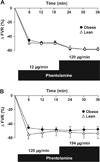Dissociation between sympathetic nerve traffic and sympathetically mediated vascular tone in normotensive human obesity
- PMID: 18695151
- PMCID: PMC4222518
- DOI: 10.1161/HYPERTENSIONAHA.107.109603
Dissociation between sympathetic nerve traffic and sympathetically mediated vascular tone in normotensive human obesity
Abstract
Obesity increases the risk of hypertension and its cardiovascular complications. This has been partly attributed to increased sympathetic nerve activity, as assessed by microneurography and catecholamine assays. However, increased vasoconstriction in response to obesity-induced sympathoactivation has not been unequivocally demonstrated in obese subjects without hypertension. We evaluated sympathetic alpha-adrenergic vascular tone in the forearm by brachial arterial infusion of the alpha-adrenoreceptor antagonist phentolamine (120 microg/min) in normotensive obese (daytime ambulatory arterial pressure: 123+/-1/77+/-1 mm Hg; body mass index: 35+/-1 kg/m(2)) and lean (daytime ambulatory arterial pressure: 123+/-2/77+/-2 mm Hg; body mass index: 22+/-1 kg/m(2)) subjects (n=25 per group) matched by blood pressure, age, and gender. Microneurographic sympathetic nerve activity to skeletal muscle was significantly higher in obese subjects (30+/-3 versus 22+/-1 bursts per minute; P=0.02). Surprisingly, complete alpha-adrenergic receptor blockade by phentolamine (at concentrations sufficient to completely inhibit norepinephrine and phenylephrine-induced vasoconstriction) caused equivalent vasodilatation in obese (-57+/-2%) and lean subjects (-57+/-3%; P=0.9). In conclusion, sympathetic vascular tone in the forearm circulation is not increased in obese normotensive subjects despite increased sympathetic outflow. Vasodilator factors or mechanisms occurring in obese normotensive subjects could oppose the vasoconstrictor actions of increased sympathoactivation. Our findings may help to explain why some obese subjects are protected from the development of hypertension.
Figures




References
-
- Cox BD, Whichelow MJ, Ashwell M, Prevost AT, Lejeune SR. Association of anthropometric indices with elevated blood pressure in British adults. Int J Obes (Lond) 1997;21:674–680. - PubMed
-
- Kortelainen ML, Sarkioja T. Coronary atherosclerosis and myocardial hypertrophy in relation to body fat distribution in healthy women: an autopsy study on 33 violent deaths. Int J Obes Relat Metab Disord. 1997;21:43–49. - PubMed
-
- Engeli S, Sharma AM. Role of adipose tissue for cardiovascular-renal regulation in health and disease. Horm Metab Res. 2000;32:485–499. - PubMed
-
- Julius S, Valentini M, Palatini P. Overweight and hypertension. A 2-way street? Hypertension. 2000;35:807–813. - PubMed
Publication types
MeSH terms
Substances
Grants and funding
LinkOut - more resources
Full Text Sources
Other Literature Sources
Medical

